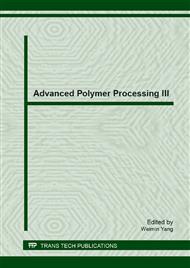p.285
p.291
p.296
p.302
p.307
p.313
p.319
p.326
p.331
Research on the Optimal Rotor Speed of the Mixing-Molding Integrative Machine
Abstract:
This article is targeted at different rotor configurations, using of laboratory experimental platform of existing small synchronous rotor of internal mixer, under consistent conditions of cooling water temperature, floating weight pressure, filling coefficient, along with the change of rotor speed, experimental study on five different rotor configurations. Through comparison of the experimental results, choose the best rotor speed, and for further experimental research to provide the optimal parameter selection basis, to ensure that the mixing performance of the mixing-molding integrative machine.
Info:
Periodical:
Pages:
307-312
Citation:
Online since:
July 2013
Authors:
Price:
Сopyright:
© 2013 Trans Tech Publications Ltd. All Rights Reserved
Share:
Citation:


